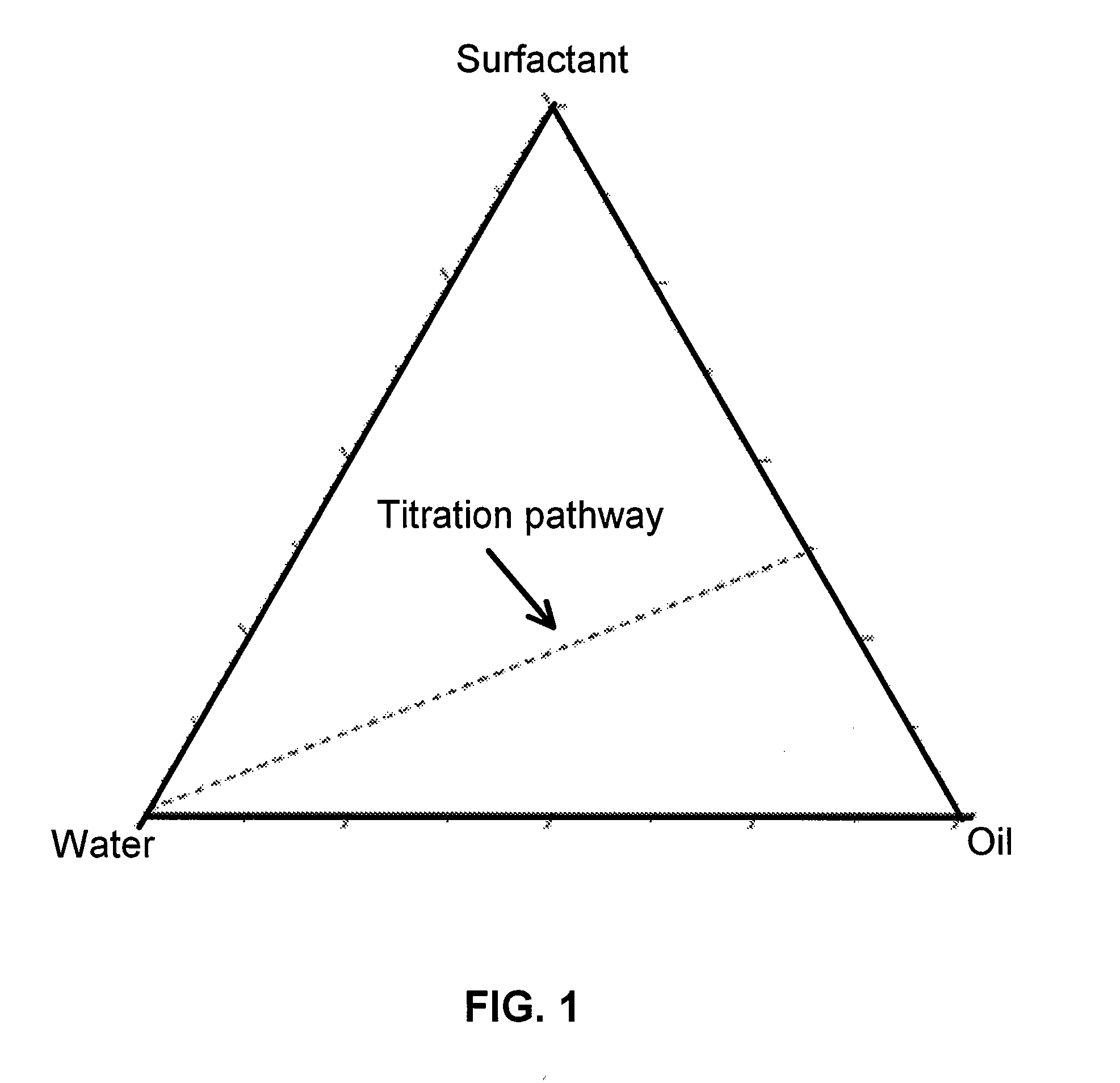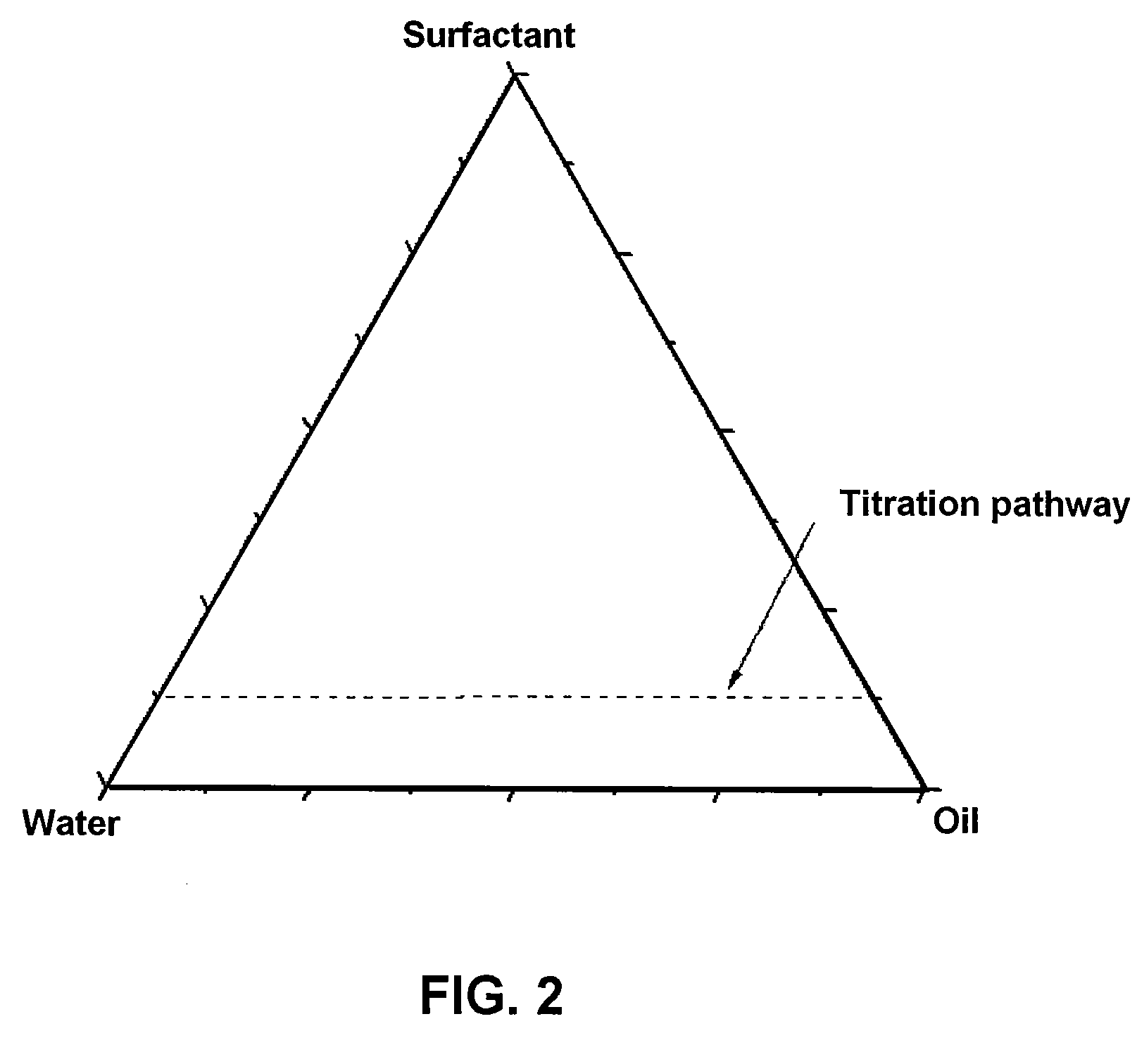Nanoporous and microporous solvogels and nonolatexes by microemulsion polymerization
a technology of nanoporous solvogels and microporous solvogels, which is applied in the field of nanoporous microporous solvogels and nonolatexes by microemulsion polymerization, can solve the problems of inability to yield one-to-one structural copies of the pre-polymerization amphiphile aggregates, the workup is tedious, and the stability of bicontinuous microemulsions stabilized by non-
- Summary
- Abstract
- Description
- Claims
- Application Information
AI Technical Summary
Benefits of technology
Problems solved by technology
Method used
Image
Examples
example 1
[0145]Synthesis of 1-dodecyl-3-methylimidazolium bromide. A mixture of 1-bromododecane (12.4 g, 50 mmol) and 1-methylimidazole (4.1 μg, 50 mmol) was stirred at 75° C. for 24 h. The viscous liquid was washed with ethyl acetate several times and heated at 85° C. under vacuum for 24 h to produce waxy 1-dodecyl-3-methylimidazolium bromide (15.64 g, 83%). 1H NMR (400 MHz, CDCl3): 10.61 (1H, m, N—CH—N), 7.25-7.34 (2H, s, N—CH═CH—N), 4.32-4.30 (2H, t, N—CH2(CH2)10CH3), 4.12 (3H, s, N—CH3), 1.91-1.90 (2H, m, N—CH2(CH2)10CH3), 1.32-1.23 (18H, m, N—CH2(CH2)10CH3), 0.87-0.84 (3H, t, N—CH2(CH2)10CH3). Elemental analysis: Calculated C16H32BrN2: C 57.28%, H, 9.71%, N, 8.43%; Found: C, 56.62%, H, 9.49%, N, 8.35%. mp: 39.7° C.
example 2
[0146]Synthesis of 1-dodecyl-3-methylimidazolium tetrafluoroborate. 1-Dodecyl-3-methylimidazolium bromide (6.62 g, 20 mmol, a-Br) was dissolved in 50 mL of dry acetonitrile and stirred with NaBF4 (2.75 g, 25 mol) at 40° C. After the mixture was stirred for 48 h, the sodium bromide precipitate was removed by filtration and the filtrate was concentrated. The concentrated filtrate was diluted with methylene chloride (300 mL) and filtered through a short column of silica gel. The Br-concentration was checked qualitatively by the formation of AgCl after adding of silver nitrate (AgNO3) into the decanted water. The resulting ionic liquid 1-dodecyl-3-methylimidazolium tetrafluoroborate was heated at 80° C. under vacuum for 12 h. (5.49 g, 81% yield). 1H NMR (400 MHz, CDCl3): 0.84-0.88 (3H), 1.24-1.31 (18H), 1.84-1.87 (2H), 3.95 (3H), 4.14-4.18 (2H), 7.25-7.30 (2H), 8.84 (1H). mp: 31.1° C.
example 3
[0147]Synthesis of 1-acryloylundecyl-3-methylimidazolium bromide. The intermediate 11-bromoundecylacrylate is first synthesized as shown in Scheme 3. 11-Bromoundecanol (10.00 g, 40 mmol) was dissolved in 40 ml of dry tetrahydrofuran (THF) in a two-necked round bottom flask. The flask was cooled in an ice-bath and triethylamine (5.13 mL, 40 mmol) in THF (40 mL) was added to the stirring solution. Acryloyl chloride (3.65 g, 40 mmol) dissolved in 40 ml of THF was added dropwise to the stirring solution over a period of 15 min under N2 atmosphere. The mixture was further stirred for 2 days at room temperature and was filtered. The filtrate was washed with 2% sodium bicarbonate solution to remove any unreacted acid chloride and dried over anhydrous MgSO4. The dried solution was filtered and the filtrate was passed through a short column of neutral alumina, using CH2Cl2 as the light yellow liquid (yield 10.58 g, 87%). 1H NMR (400 MHz, CDCl3): 6.37-6.36 (1H, m, CH2═CH), 6.15-6.12 (1H, m, C...
PUM
| Property | Measurement | Unit |
|---|---|---|
| melting point | aaaaa | aaaaa |
| melting point | aaaaa | aaaaa |
| melting point | aaaaa | aaaaa |
Abstract
Description
Claims
Application Information
 Login to View More
Login to View More - R&D
- Intellectual Property
- Life Sciences
- Materials
- Tech Scout
- Unparalleled Data Quality
- Higher Quality Content
- 60% Fewer Hallucinations
Browse by: Latest US Patents, China's latest patents, Technical Efficacy Thesaurus, Application Domain, Technology Topic, Popular Technical Reports.
© 2025 PatSnap. All rights reserved.Legal|Privacy policy|Modern Slavery Act Transparency Statement|Sitemap|About US| Contact US: help@patsnap.com



